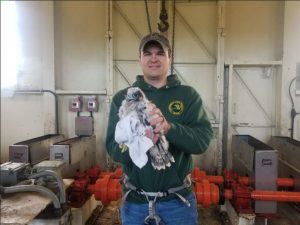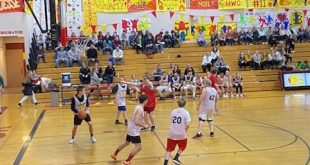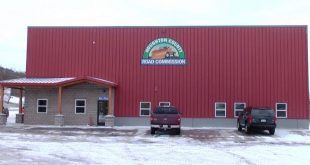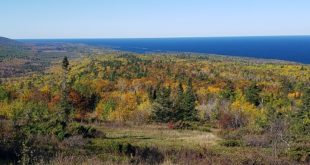
Another pair of peregrine falcons are successfully nesting on the Portage Lake Lift Bridge again this year.
The Michigan Department of Transportation installed two nest boxes in 2012 – one each on the north and south bridge towers.
A pair of falcons discovered the nesting site the next spring and has now raised a total of 15 chicks there.
A webcam has been set up to view the endangered birds in cooperation with the Copper Country Audubon Society to allow people to watch nesting activity there.
The chicks at the Lift Bridge were banded by a Michigan Department of Natural Resources team on June 20.

Color-coded bands attached to the legs of young birds allow scientists to track the movements, reproductive behavior and population growth of the falcons.
In addition to their leg bands, the peregrine chicks received names.
DNR and bridge staff named the males Hawkeye and Boden, while the female was dubbed Harmony.
The new peregrines should be ready to leave the nest in another few weeks.
Here is the full press release from MDOT:
July 2, 2018 — It’s been a productive summer for Upper Peninsula bridges and their resident raptors, with peregrine falcons at the Sault Ste. Marie International Bridge successfully raising a chick and the Portage Lake Lift Bridge between Houghton and Hancock seeing three hatchlings this spring.
On the eastern end of the U.P., Karl Hansen, bridge engineer for the International Bridge Administration (IBA), reported that a pair of peregrine falcons successfully nested atop the bridge between the U.S. and Canada this spring, hatching two chicks – one of which died after hatching.
Nest boxes for the peregrines have been installed since 2010 on the International Bridge’s U.S. and Canadian arches. Last year, the same pair of peregrine falcons successfully nested on the International Bridge, hatching four chicks. The site has hatched 24 falcon chicks since 2010, when the nest box was installed and IBA staff started counting the birds, Hansen said.
The IBA has a new nest camera, the “FalCam,” which has proven very popular. Since the live video stream, viewable at www.saultbridge.com/falcam, went online, the IBA has seen website usage increase by 46 percent. The camera came online this spring just in time for the seasonal return of the endangered raptors.
At the other end of the U.P., on the Portage Lake Lift Bridge, the Michigan Department of Transportation (MDOT) installed two nest boxes in 2012 – one each on the north and south bridge towers. A pair of falcons discovered the nesting site the next spring and has now raised a total of 15 chicks there. A webcam, viewable at http://pasty.com/nestbox.html, has been installed in cooperation with the Copper Country Audubon Society to allow people to watch nesting activity there.
The chicks at the Lift Bridge were banded by a Michigan Department of Natural Resources (DNR) team on June 20, while the International Bridge birds were banded by a team on June 26. Color-coded bands attached to the legs of young birds allow scientists to track the movements, reproductive behavior and population growth of the falcons.
In addition to their leg bands, the peregrine chicks received names. At the International Bridge, the bridge staff collaborated with the Sault Ste. Marie Michigan Convention and Visitor’s Bureau to name their bird in conjunction with the city’s 350th anniversary this summer. The chick was named Susan, after Susan Johnston (Ozhaguscodaywayquay in Ojibwe), the wife of a fur trader and a prominent Sault resident in the early 1800s. Around 1820, she helped dissuade Ojibwe leaders from attacking a treaty delegation led by Gov. Lewis Cass.
At the Lift Bridge, DNR and bridge staff named the males Hawkeye and Boden, while the female was dubbed Harmony. The new peregrines at both bridges should be ready to leave the nest in another few weeks.
Michigan lost its peregrine falcons in the 1960s and 1970s due to the use of DDT and other environmental contaminants. Since conservation efforts started in the mid-1980s, the number of peregrine nests has slowly increased. Now there are about 40 falcon pairs actively trying to nest statewide, with one to two new pairs discovered most years.
The peregrine falcon has been removed from the federal endangered species list, but is listed as an endangered species in Michigan, protected by state and federal law. Peregrines have adapted to city habitats, nesting on tall buildings, smokestacks and bridges around the world.
High-speed hunters capable of flying at 200 mph, the peregrines may help keep populations of nuisance pigeons under control. While researchers have found pigeons make up a relatively small portion of the falcon diet, the dangerous predators may play a role in frightening them away from bridges. Keeping pigeons away is seen as potentially saving MDOT and the IBA maintenance money down the line, as pigeon droppings can damage paint on metal bridge surfaces.
 Keweenaw Report Your Source for Local News and Sports
Keweenaw Report Your Source for Local News and Sports





